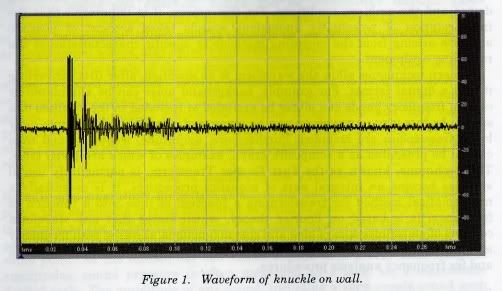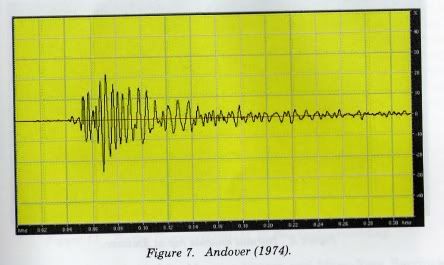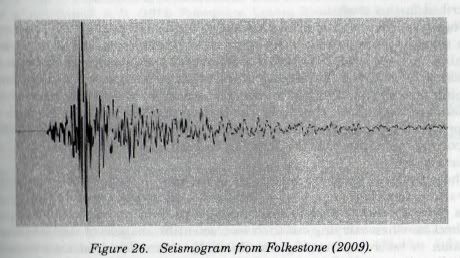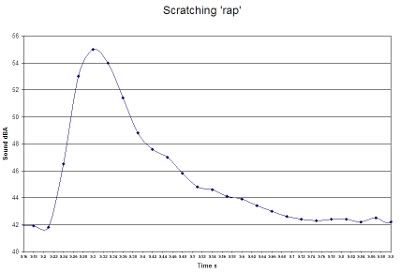Posted: Jul 25, 2010 10:46 am
Contender's #6 post: 1704 words - Mr.Samsa
I’d like to thank all of you, Jerome in particular, for your patience! School’s out now (yay!), so I have a little more time on my hands for extra-curricular pursuits!
In this post I will respond to the claims made by Dr Barry Colvin and the psychomanteum experimenters. I will also include some Campermon Beer Mat Physics TM.
Without further ado, let’s crack on….
Dr Barrie Colvin’s Paper – “The Acoustic Properties of Unexplained Rapping Sounds”
First of all, many thanks to Jerome who shared the paper with me. In the following I will discuss the findings of Colvin’s paper and also add some of my own brand of beer mat physics in order to suggest some further work that Colvin may wish to pursue.
To give you a flavour of the paper I hereby reproduce the abstract;
The wave characteristics of unexplained rapping sounds have been studied and compared with similar-sounding raps produced using normal tapping methods. Differences in low-frequency wave properties between the two classes of sounds have been noted. There are indications that the acoustic properties of the two classes of sound are different and that this technique can be used to differentiate between normal and inexplicable rapping sounds witnessed during RSPK activity. A tentative theory of localized stress development followed by a sudden release of tension has been put forward to account for the rapping sounds.
At the outset I must state that I agree with Colvin’s conclusion that the ‘genuine’ rapping sounds presented in this paper are indeed distinguishable from the ‘normal’ rapping sounds that have been produced for the matter of this study. However, once again I feel that Dr Colvin has not being thorough enough in his investigations and has thus led himself to the edge of the abyss in trying to formulate an explanation for the ‘genuine’ rappings. But more of that later.
In the paper, Colvin essentially shows that there are quantitative differences between manufactured ‘normal’ raps and ‘genuine’ ones. Even if, qualitatively, these raps appear to sound the same, differences can be shown with the use of acoustic analysis as is shown here;


As well as rapping knuckles on walls, Colvin also goes on to investigate the acoustic signatures of impacting rubber hammers on objects and tapping glasses. All of the results show a similar acoustic picture i.e. a rapid increase in amplitude followed by some sort of exponential decay, which is exactly what one might expect. It is obvious that the raps that he has manufactured are indeed quantitatively different from the ‘real’ thing.
So, what can we conclude from Colvin’s findings? Well; hitting objects does not produce similar acoustic signatures to the similar that are allegedly genuine poltergeist raps. And that’s it. Basically he’s ruled out hitting objects as being a possible mechanism.
Colvin, to his credit, does acknowledge and account for variability due to the differing microphone technology that was used to gather the data but, crucially, he does not investigate other means of generating raps that might, qualitatively, appear to sound the same as a ‘real’ rap. He writes;
“There appear to be reasonable grounds for concluding that the unexplained rapping effect produced at various apparent poltergeist cases in a variety of countries exhibit an unusual acoustic waveform pattern, characterized by a relatively slow rise to maximum amplitude, followed by an equally slow decline in amplitude.”
He then goes on to conjecture that;
“The unexplained rapping effects described in this study are clearly different from this [raps produced by hitting objects] and appear to involve the relatively slow build up of stress within the material, culminating in an audible sound when the stress reaches a specific magnitude. The reasons for and the precise physics of this mechanism are unknown and will require a substantial amount of experimental work to determine the underlying principles in their production.”
Colvin then shows us that the acoustic signature of a ‘real’ rap is similar in shape (but on a different amplitude / time scale) to seismic events. Here is an example from the paper;

So, what are we to make of all this? Do we need to search for new mechanisms that would allow stresses to spontaneously build up and release in materials? Where do we begin?
The similarity of ‘real’ raps with seismic ‘raps’ got me thinking. In particular, I got to thinking about earthquakes and how they generate waves. One way to make an earthquake to happen is to allow two surfaces to slide past each other. If the surfaces happen to be ‘rough’ they can get stuck which leads to a build up of stress (which stores energy) which is eventually released as seismic waves (an earthquake). This is an extremely simple explanation! You can read more here; http://en.wikipedia.org/wiki/Earthquake
Now, this is where I believe that Colvin has gone wrong in his investigation; he concludes that this build up of stress is actually occurring within the material that the raps are apparently emitted from. If we go down this route, we are indeed in trouble because we need to explain why the material, in a table for example, would spontaneously get stressed / de-stressed etc.. Where does the energy come from? And so on.
A tricky problem which required a little thought, some beer and a Campermon Beer Mat PhysicsTM experiment…
Inspired by the mechanics of earthquakes (and a couple of beers), I set out to see if I could generate a ‘rap’ which would have an acoustic signature which would have a relatively long build up in amplitude when compared to a rap which was generated by hitting an object BUT would qualitatively sound very similar.
For this experiment I used;
An ‘Easysense Q3’ data logger – utilizing its built in dB meter
MS Office Excel
The nail on my right hand index finger (it’s long because I play guitar)
The method I followed was simple;
1) Place the microphone in contact with the kitchen work top.
2) Start logging direct to the computer
3) Place the index finger underneath the work top
4) ‘Rap’ the underneath of the work top.
I experimented by tapping with my finger nail (i.e. hitting the surface) and also scratching the surface with my nail. I discovered that I could make the ‘scratches’ sound very similar to the taps.
I obtained a number of results and a cursory look at these showed me that the scratching ‘rap’ did produce signatures with a slightly larger build up to maximum amplitude. Please note that the two sounds shown did sound qualitatively similar. I’m afraid that I don’t have any recording gear, so you’ll have to take my word for it!
A typical tapping sound produced a signature which reached maximum amplitude within 0.05 seconds:

A typical scratching sound produced a signature which reached a maximum amplitude within a relatively longer time of 0.09 seconds:

As can be seen, the amplitude signatures of these raps does show slight differences i.e. the scratching ‘raps’ do show a relatively longer build up time. This can be explained if we consider what is happening to the nail as it passes along the surface of the worktop; As the nail is dragged across the surface it gets stuck, stress builds up (energy is stored in the elastic nail) and this energy is released to produce vibrations.
OK, I’ll admit that this is pretty rough experiment and I haven’t taken into account the limitations of the apparatus (i.e. uncertainty in time measurements etc). What I have tried to show is that there maybe an alternative, mundane, method for creating raps which exhibit the properties Colvin presents. Plus, if I was to trick someone into believing that raps were ‘genuine’ I’d pick a method such as scratching or clicking some mechanism simply because the action of making the sound would be less apparent than having to hit something.
In closing, I would advise Colvin to perhaps consider broadening his investigations into generating raps before he begins to theorize that stresses may be building up in the actual fabric of the rapping medium.
Psychomanteum results
Thanks to Jerome for sharing the results of this experiment with us;

So, what’s it all about? Well, I managed to get the gist of what the experimenters were trying to do from here; http://books.google.co.uk/books?hl=en&l ... &q&f=false page 164+
Unfortunately, because it is a google book preview, a few of the pages are missing, but a read of what’s there gives you the general idea of what these guys were up to!
Basically, the experimenters wired up participants with lots of physiological data probes and stuck them in the psychomanteum which was also wired up with lots of probes to record environmental data. All of this data, from the environment and the participant, was recording during the sessions, the data then synchronized and number crunched to look for correlations (shown in the table Jerome shared with us).
Now….Call me cynical, but my immediate thoughts led me to think:

http://en.wikipedia.org/wiki/Flying_Spaghetti_Monster
OK, we all know that correlation does not imply causation, so I won’t labour the point.
I do not doubt that the researchers have found some correlations in their datasets and I salute them for their number crunching abilities. Given enough data, and they had lots, we can always find a correlation.
Without the raw results of their experiments I cannot comment any further!
Now, I’ve kept this post short so I could get it out quickly! (Sorry for the delay). In my next post I will look forward to spending some time discussing the ‘defence’ that Jerome will present;
“….in my next post I will bring some more scientific studies to bear, from names familiar to many readers of this forum (Richard Wiseman among others) and then start to tie my argument together in to a defence of my apparently unlikely claim, and to make what I hope will be a strong defence of my position.”
As is customary in these affairs, I will finish with a quote which I dedicate to Dr Barrie Colvin;
"Make everything as simple as possible, but not simpler."
Alert Einstein

I’d like to thank all of you, Jerome in particular, for your patience! School’s out now (yay!), so I have a little more time on my hands for extra-curricular pursuits!
In this post I will respond to the claims made by Dr Barry Colvin and the psychomanteum experimenters. I will also include some Campermon Beer Mat Physics TM.
Without further ado, let’s crack on….
Dr Barrie Colvin’s Paper – “The Acoustic Properties of Unexplained Rapping Sounds”
First of all, many thanks to Jerome who shared the paper with me. In the following I will discuss the findings of Colvin’s paper and also add some of my own brand of beer mat physics in order to suggest some further work that Colvin may wish to pursue.
To give you a flavour of the paper I hereby reproduce the abstract;
The wave characteristics of unexplained rapping sounds have been studied and compared with similar-sounding raps produced using normal tapping methods. Differences in low-frequency wave properties between the two classes of sounds have been noted. There are indications that the acoustic properties of the two classes of sound are different and that this technique can be used to differentiate between normal and inexplicable rapping sounds witnessed during RSPK activity. A tentative theory of localized stress development followed by a sudden release of tension has been put forward to account for the rapping sounds.
At the outset I must state that I agree with Colvin’s conclusion that the ‘genuine’ rapping sounds presented in this paper are indeed distinguishable from the ‘normal’ rapping sounds that have been produced for the matter of this study. However, once again I feel that Dr Colvin has not being thorough enough in his investigations and has thus led himself to the edge of the abyss in trying to formulate an explanation for the ‘genuine’ rappings. But more of that later.
In the paper, Colvin essentially shows that there are quantitative differences between manufactured ‘normal’ raps and ‘genuine’ ones. Even if, qualitatively, these raps appear to sound the same, differences can be shown with the use of acoustic analysis as is shown here;


As well as rapping knuckles on walls, Colvin also goes on to investigate the acoustic signatures of impacting rubber hammers on objects and tapping glasses. All of the results show a similar acoustic picture i.e. a rapid increase in amplitude followed by some sort of exponential decay, which is exactly what one might expect. It is obvious that the raps that he has manufactured are indeed quantitatively different from the ‘real’ thing.
So, what can we conclude from Colvin’s findings? Well; hitting objects does not produce similar acoustic signatures to the similar that are allegedly genuine poltergeist raps. And that’s it. Basically he’s ruled out hitting objects as being a possible mechanism.
Colvin, to his credit, does acknowledge and account for variability due to the differing microphone technology that was used to gather the data but, crucially, he does not investigate other means of generating raps that might, qualitatively, appear to sound the same as a ‘real’ rap. He writes;
“There appear to be reasonable grounds for concluding that the unexplained rapping effect produced at various apparent poltergeist cases in a variety of countries exhibit an unusual acoustic waveform pattern, characterized by a relatively slow rise to maximum amplitude, followed by an equally slow decline in amplitude.”
He then goes on to conjecture that;
“The unexplained rapping effects described in this study are clearly different from this [raps produced by hitting objects] and appear to involve the relatively slow build up of stress within the material, culminating in an audible sound when the stress reaches a specific magnitude. The reasons for and the precise physics of this mechanism are unknown and will require a substantial amount of experimental work to determine the underlying principles in their production.”
Colvin then shows us that the acoustic signature of a ‘real’ rap is similar in shape (but on a different amplitude / time scale) to seismic events. Here is an example from the paper;

So, what are we to make of all this? Do we need to search for new mechanisms that would allow stresses to spontaneously build up and release in materials? Where do we begin?
The similarity of ‘real’ raps with seismic ‘raps’ got me thinking. In particular, I got to thinking about earthquakes and how they generate waves. One way to make an earthquake to happen is to allow two surfaces to slide past each other. If the surfaces happen to be ‘rough’ they can get stuck which leads to a build up of stress (which stores energy) which is eventually released as seismic waves (an earthquake). This is an extremely simple explanation! You can read more here; http://en.wikipedia.org/wiki/Earthquake
Now, this is where I believe that Colvin has gone wrong in his investigation; he concludes that this build up of stress is actually occurring within the material that the raps are apparently emitted from. If we go down this route, we are indeed in trouble because we need to explain why the material, in a table for example, would spontaneously get stressed / de-stressed etc.. Where does the energy come from? And so on.
A tricky problem which required a little thought, some beer and a Campermon Beer Mat PhysicsTM experiment…
Inspired by the mechanics of earthquakes (and a couple of beers), I set out to see if I could generate a ‘rap’ which would have an acoustic signature which would have a relatively long build up in amplitude when compared to a rap which was generated by hitting an object BUT would qualitatively sound very similar.
For this experiment I used;
An ‘Easysense Q3’ data logger – utilizing its built in dB meter
MS Office Excel
The nail on my right hand index finger (it’s long because I play guitar)
The method I followed was simple;
1) Place the microphone in contact with the kitchen work top.
2) Start logging direct to the computer
3) Place the index finger underneath the work top
4) ‘Rap’ the underneath of the work top.
I experimented by tapping with my finger nail (i.e. hitting the surface) and also scratching the surface with my nail. I discovered that I could make the ‘scratches’ sound very similar to the taps.
I obtained a number of results and a cursory look at these showed me that the scratching ‘rap’ did produce signatures with a slightly larger build up to maximum amplitude. Please note that the two sounds shown did sound qualitatively similar. I’m afraid that I don’t have any recording gear, so you’ll have to take my word for it!
A typical tapping sound produced a signature which reached maximum amplitude within 0.05 seconds:

A typical scratching sound produced a signature which reached a maximum amplitude within a relatively longer time of 0.09 seconds:

As can be seen, the amplitude signatures of these raps does show slight differences i.e. the scratching ‘raps’ do show a relatively longer build up time. This can be explained if we consider what is happening to the nail as it passes along the surface of the worktop; As the nail is dragged across the surface it gets stuck, stress builds up (energy is stored in the elastic nail) and this energy is released to produce vibrations.
OK, I’ll admit that this is pretty rough experiment and I haven’t taken into account the limitations of the apparatus (i.e. uncertainty in time measurements etc). What I have tried to show is that there maybe an alternative, mundane, method for creating raps which exhibit the properties Colvin presents. Plus, if I was to trick someone into believing that raps were ‘genuine’ I’d pick a method such as scratching or clicking some mechanism simply because the action of making the sound would be less apparent than having to hit something.
In closing, I would advise Colvin to perhaps consider broadening his investigations into generating raps before he begins to theorize that stresses may be building up in the actual fabric of the rapping medium.
Psychomanteum results
Thanks to Jerome for sharing the results of this experiment with us;

So, what’s it all about? Well, I managed to get the gist of what the experimenters were trying to do from here; http://books.google.co.uk/books?hl=en&l ... &q&f=false page 164+
Unfortunately, because it is a google book preview, a few of the pages are missing, but a read of what’s there gives you the general idea of what these guys were up to!
Basically, the experimenters wired up participants with lots of physiological data probes and stuck them in the psychomanteum which was also wired up with lots of probes to record environmental data. All of this data, from the environment and the participant, was recording during the sessions, the data then synchronized and number crunched to look for correlations (shown in the table Jerome shared with us).
Now….Call me cynical, but my immediate thoughts led me to think:

http://en.wikipedia.org/wiki/Flying_Spaghetti_Monster
OK, we all know that correlation does not imply causation, so I won’t labour the point.
I do not doubt that the researchers have found some correlations in their datasets and I salute them for their number crunching abilities. Given enough data, and they had lots, we can always find a correlation.
Without the raw results of their experiments I cannot comment any further!
Now, I’ve kept this post short so I could get it out quickly! (Sorry for the delay). In my next post I will look forward to spending some time discussing the ‘defence’ that Jerome will present;
“….in my next post I will bring some more scientific studies to bear, from names familiar to many readers of this forum (Richard Wiseman among others) and then start to tie my argument together in to a defence of my apparently unlikely claim, and to make what I hope will be a strong defence of my position.”
As is customary in these affairs, I will finish with a quote which I dedicate to Dr Barrie Colvin;
"Make everything as simple as possible, but not simpler."
Alert Einstein